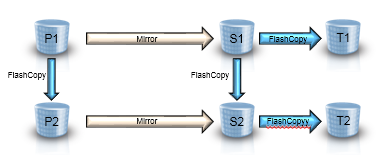Cascading FlashCopy
Cascading FlashCopy is an enhancement to FlashCopy which provides additional capabilities and flexibility. With FlashCopy, point-in-time copies of data can be made nearly instantaneously. Both the original (source) and the copy (target) are then immediately available for read and write access.

Multiple copies of the source data can be made to create backups of the source data at various times.

Now with Cascading FlashCopy, available in DS8880 Release 8.3, a FlashCopy can be created from the target of an existing FlashCopy pair. In other words, Cascading FlashCopy allows for the creation of a copy of a copy, where A is first copied to B and then B is later copied to C.

Not only may the target data be copied to a second target, but it is also possible for the source data of an existing relationship to become the target of a new relationship.

This flexibility provides new or simplified functionality for operations such as:
- Restoring from one of multiple FlashCopy Backups
- Global Mirror Recovery
- Multiple Dataset Level Flash Copies
- Remote Pair and Full Volume FlashCopy
Data Restore with Multiple FlashCopy Backups
Let’s look at the case of restoring data from one of a multitude of FlashCopy targets. Consider an example where several different copies of a source volume have been made at different times.
- Copy T1 created at 1:00 pm
- Copy T2 created at 2:00 pm
- Copy T3 created at 3:00 pm

At 3:30pm it is decided to restore data to the source volume S using the data saved on T3 at 3:00 pm. This is done by performing a reverse FlashCopy from T3→S.

This creates cascaded copies of T3→S→T1 and T3→S→T2. Without the functionality of Cascading FlashCopy, it is necessary to first remove the S→T1 and S→T2 relationships before performing the Reverse FlashCopy T3→S. With Cascading FlashCopy, the T2 and T3 copies of data can be maintained. If it is later decided that the T2 copy is needed, the T3→S copy can be removed and the S volume restored from T2 or T1. Without Cascading FlashCopy, this is not possible.
Global Mirror Recovery
Another frequent scenario is to recover data at a Global Mirror remote site. Global Mirror uses FlashCopy to maintain the journal volumes containing the consistent data required for recovery. It is common to also create additional copies of data to use for testing purposes. After an outage, a Safety Copy is typically taken to preserve the last consistent copy of data at the time of the outage in case it is later needed.
This results in the situation of having 3 (or possibly more) FlashCopy relationships on the Global Mirror secondary volumes.

Cascading FlashCopy allows the Global Mirror secondary volumes to be restored from the journal volumes while still maintaining these other Test and Safety copies.

Without the new capabilities that are now available in DS8880 Release 8.3, you must first remove all of these Test and Safety copies before restoring the last consistency group from the Journal volumes. If the background copy is still in progress, then you either lose the data for these copies or you have to wait for all of these background copies to complete, causing a long delay before the recovery can be performed. With Cascading FlashCopy however, the recovery can be done immediately while also preserving all of the data for the Test and Safety copies.
Defrag Performance
Besides the simplifications and usefulness that Cascading FlashCopy brings, it can also lead to improved performance by allowing the use of FlashCopy where it previously was not possible. As an example, consider a defrag operation where datasets are moved within a volume to create a more efficient data placement. FlashCopy can move the datasets almost instantly and without the need to physically read and re-write the data.
However, without Cascading FlashCopy, as soon as a situation occurs where the target location is already the source of a previous move, then the use of FlashCopy is curtailed and the move must be performed by the slower method of reading and writing the data with traditional I/O.
As an example, the following diagram shows FlashCopy being used to relocate dataset A from blocks 12-14 to blocks 3-5. Then dataset B is relocated to blocks 12-13 which are now in a FlashCopy source relationship. This creates a cascaded relationship which was previously not possible. But now with the Cascading FlashCopy capability, FlashCopy can be used and will greatly improve the speed of the defrag operation.

Remote Pair FlashCopy with Remote Backups
Cascading FlashCopy allows the use of Remote Pair FlashCopy in situations where it was previously not possible.
With Remote Pair FlashCopy, a FlashCopy command between two Metro Mirror source volumes is mirrored to the secondary volumes.

Now consider a Metro Mirror environment where FlashCopy is also used to make copies of the Metro Mirror secondary volumes at the remote site here:

Without Cascading FlashCopy, you cannot combine these two uses because mirroring a Remote Pair FlashCopy from P1→P2 to S1→S2 results in a cascaded FlashCopy relationship of S1→S2→T2. With the new capabilities of Cascading FlashCopy, however, new possibilities such as this are allowed.

Summary
Cascading FlashCopy is a significant enhancement to FlashCopy which opens up a wide variety of new possibilities. Eliminating the need to remove previously established relationships allows for simpler, faster, and more efficient procedures. In other cases, FlashCopy can now be used where it previously was not even possible, allowing for significant performance improvements and added flexibility.
#DS8000#DS8880#EnterpriseStorage